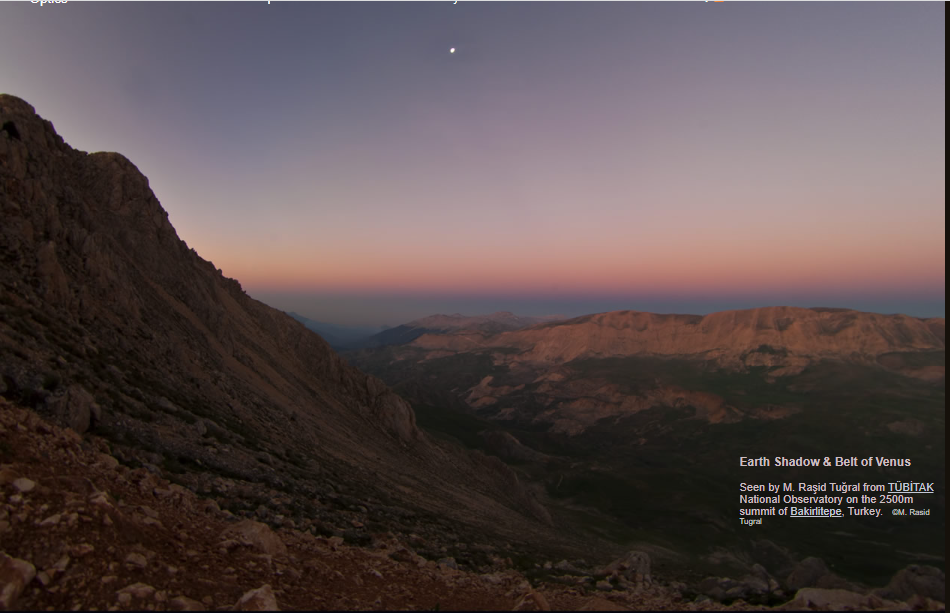OPOD - Earth Shadow
Earth Shadow: Exploring the Enigmatic Belt of Venus
As the sun gracefully descends below the western horizon, a captivating phenomenon takes place. A dark band begins to emerge along the eastern horizon, suffused with a delicate pink glow. This ethereal spectacle is known as the Belt of Venus or the Anti-twilight Arch. It is a mesmerizing display that unveils itself after sunset, leaving spectators in awe of nature's artistic prowess.
The Belt of Venus owes its existence to the interplay between light and shadow in our atmosphere. The dark band that ascends along the horizon is actually unlit air, shielded from the sun's rays by the Earth itself. If one were fortunate enough to witness this phenomenon from an aircraft crossing the shadow's edge, they would witness a remarkable sight—the sun setting at high altitude.
During a sunset, the sun's rays are subject to Rayleigh scattering, causing them to appear reddened. This scattering occurs when air molecules selectively scatter shorter wavelength light, resulting in the iconic blue sky we often admire. As a result, the direct rays of the sun lose their blue hue and become denuded. These reddened rays illuminate the atmosphere along the shadow's edge, intertwining with the scattered blue light to create the mesmerizing pink hues of the Belt of Venus.
But there is more to this enigmatic phenomenon than meets the eye. Let us delve deeper into the intricacies of Earth's shadow and explore its captivating secrets:
-
A Celestial Ballet: The Belt of Venus is a celestial ballet that unfolds during twilight, enchanting viewers with its delicate colors and ethereal beauty.
-
Shadow and Light: Earth's shadow plays a vital role in creating this phenomenon. As sunlight passes through our planet's atmosphere, it undergoes various interactions, resulting in breathtaking displays like the Belt of Venus.
-
A Universal Sight: Although the Belt of Venus is most commonly observed after sunset, it can also be witnessed before sunrise. In these instances, it appears as a dark band along the western horizon, complemented by a pinkish glow.
-
Optical Illusion: The Belt of Venus is not an actual physical band in the sky but rather an optical illusion. It is a result of the scattering and diffraction of sunlight as it traverses the atmosphere, creating a captivating visual spectacle.
-
Colors of Twilight: Twilight is a transitional period between day and night, marked by its unique colors. The Belt of Venus is just one of the many captivating phenomena that occur during this magical time.
-
Photographic Delight: The Belt of Venus is a favorite subject for photographers and astronomy enthusiasts alike. Capturing its delicate hues and subtle gradients requires both skill and patience.
-
Cultural Significance: Throughout history, various cultures have ascribed different meanings and interpretations to the Belt of Venus. From ancient folklore to modern symbolism, this celestial phenomenon has left an indelible mark on human imagination.
-
The Science Behind It: While the Belt of Venus may seem mysterious, its formation can be explained by the principles of atmospheric optics. Understanding the scientific processes at play adds a new layer of appreciation to this awe-inspiring spectacle.
-
A Global Phenomenon: The Belt of Venus can be observed from various locations around the world, making it a universal phenomenon that transcends geographical boundaries. Each location offers a unique perspective and backdrop against which this celestial ballet unfolds.
-
Nature's Artistry: The Belt of Venus serves as a reminder of the incredible beauty and intricacy present in our natural world. It is a testament to the harmonious interplay between light, shadow, and atmosphere, leaving us in awe of the wonders that surround us.
In conclusion, the Belt of Venus is a mesmerizing atmospheric optics phenomenon that captivates viewers with its delicate pink hues. As the sun sets below the horizon, the interplay between light and shadow gives rise to this enchanting display. Understanding the scientific principles behind this phenomenon adds a new layer of appreciation to its ethereal beauty. Whether witnessed in person or captured through the lens of a camera, the Belt of Venus is a celestial ballet that reminds us of nature's artistic prowess and leaves us in awe of the wonders that lie just beyond the horizon.

Earth Shadow & Belt of Venus
Seen by M. Raşid Tuğral from TÜBİTAK National Observatory on the 2500m summit of Bakirlitepe, Turkey. ©M. Rasid Tugral

The Belt of Venus at Ankara, Turkey
After sunset as the sun sinks further below the western horizon, a dark band rises up along the horizon in the east. Its edge is suffused with a pink glow - the Belt of Venus or Anti-twilight Arch.
The dark band is unlit air that is shadowed from the sun’s rays by the bulk of the Earth itself.
If you were in an aircraft crossing the shadow’s edge you would see the high altitude sun setting. Like in all sunsets its rays are reddened by Rayleigh scattering. Air molecules preferentially scatter shorter wavelength light to give blue sky and blue denuded direct rays.
The reddened rays light the atmosphere along the shadow edge. Combined with more scattered blue light they form the pinks of the Belt of Venus.

Note: this article has been automatically converted from the old site and may not appear as intended. You can find the original article here.
Reference Atmospheric Optics
If you use any of the definitions, information, or data presented on Atmospheric Optics, please copy the link or reference below to properly credit us as the reference source. Thank you!
-
<a href="https://atoptics.co.uk/blog/opod-earth-shadow/">OPOD - Earth Shadow</a>
-
"OPOD - Earth Shadow". Atmospheric Optics. Accessed on April 19, 2024. https://atoptics.co.uk/blog/opod-earth-shadow/.
-
"OPOD - Earth Shadow". Atmospheric Optics, https://atoptics.co.uk/blog/opod-earth-shadow/. Accessed 19 April, 2024
-
OPOD - Earth Shadow. Atmospheric Optics. Retrieved from https://atoptics.co.uk/blog/opod-earth-shadow/.